Atten Babler Meat FX Indices – Dec ’15
The Atten Babler Commodities Meat Foreign Exchange (FX) Indices remained at or near record high levels during Nov ’15. The USD/Meat Importer FX Index and USD/Domestic Meat Importer FX Index each increased to new record highs while the USD/Meat Exporter FX Index increased to the second highest figure on record.
Global Meat Net Trade:
Major net meat exporters are led by Brazil, followed by the U.S., the EU-28, India and Australia (represented in green in the chart below). Major net meat importers are led by Japan, followed by Russia, Mexico, Hong Kong and Saudi Arabia (represented in red in the chart below).
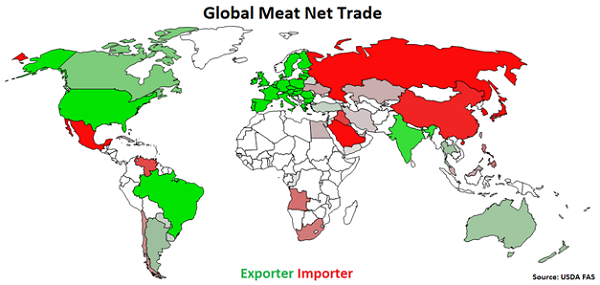 USD/Meat Exporter FX Index:
The USD/Meat Exporter FX Index increased 0.2 points in Nov ’15 to a value of 163.2, which was the second highest figure on record. The USD/Meat Exporter FX Index has increased 41.3 points since the beginning of 2014 and 16.8 points throughout the past six months. A strengthening USD/Meat Exporter FX Index reduces the competitiveness of U.S. meat relative to other exporting regions (represented in green in the Global Meat Net Trade chart), ultimately resulting in less foreign demand, all other factors being equal. USD appreciation against the Brazilian real and Argentine peso has accounted for the majority of the gains since the beginning of 2014.
USD/Meat Exporter FX Index:
The USD/Meat Exporter FX Index increased 0.2 points in Nov ’15 to a value of 163.2, which was the second highest figure on record. The USD/Meat Exporter FX Index has increased 41.3 points since the beginning of 2014 and 16.8 points throughout the past six months. A strengthening USD/Meat Exporter FX Index reduces the competitiveness of U.S. meat relative to other exporting regions (represented in green in the Global Meat Net Trade chart), ultimately resulting in less foreign demand, all other factors being equal. USD appreciation against the Brazilian real and Argentine peso has accounted for the majority of the gains since the beginning of 2014.
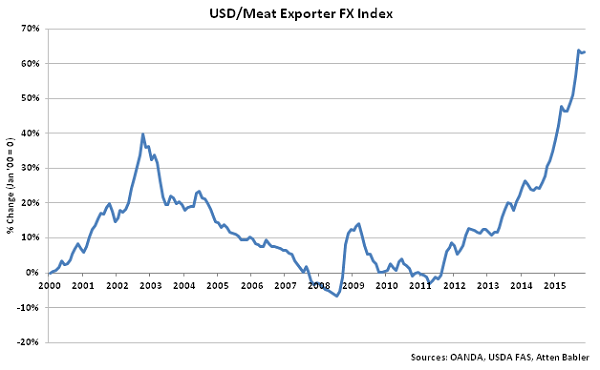 USD appreciation within the USD/Meat Exporter FX Index during Nov ’15 was led by gains against the euro, followed by USD appreciated against the Belarusian ruble, Argentine peso and Indian rupee. USD declines were exhibited against the Brazilian real.
USD appreciation within the USD/Meat Exporter FX Index during Nov ’15 was led by gains against the euro, followed by USD appreciated against the Belarusian ruble, Argentine peso and Indian rupee. USD declines were exhibited against the Brazilian real.
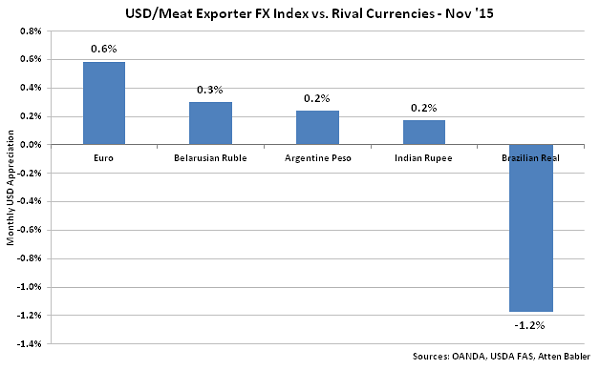 USD/Meat Importer FX Index:
The USD/Meat Importer FX Index increased 2.4 points in Nov ’15 to a new record high value of 227.2. The USD/Meat Importer FX Index has increased 47.4 points since the beginning of 2014 and 23.0 points throughout the past six months. A strengthening USD/Meat Importer FX Index results in less purchasing power for major meat importing countries (represented in red in the Global Meat Net Trade chart), making U.S. meat more expensive to import. USD appreciation against the Angolan kwanza and the Russian ruble has accounted for the majority of the gains since the beginning of 2014.
USD/Meat Importer FX Index:
The USD/Meat Importer FX Index increased 2.4 points in Nov ’15 to a new record high value of 227.2. The USD/Meat Importer FX Index has increased 47.4 points since the beginning of 2014 and 23.0 points throughout the past six months. A strengthening USD/Meat Importer FX Index results in less purchasing power for major meat importing countries (represented in red in the Global Meat Net Trade chart), making U.S. meat more expensive to import. USD appreciation against the Angolan kwanza and the Russian ruble has accounted for the majority of the gains since the beginning of 2014.
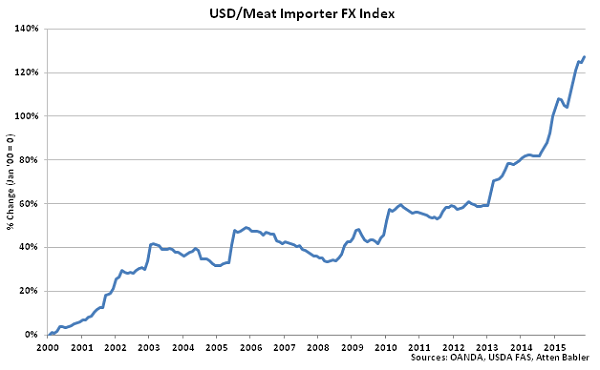 USD appreciation within the USD/Meat Importer FX Index during Nov ’15 was led by gains against the Russian ruble, followed by USD appreciated against the Ukraine hryvnia, Japanese yen, South African rand and euro.
USD appreciation within the USD/Meat Importer FX Index during Nov ’15 was led by gains against the Russian ruble, followed by USD appreciated against the Ukraine hryvnia, Japanese yen, South African rand and euro.
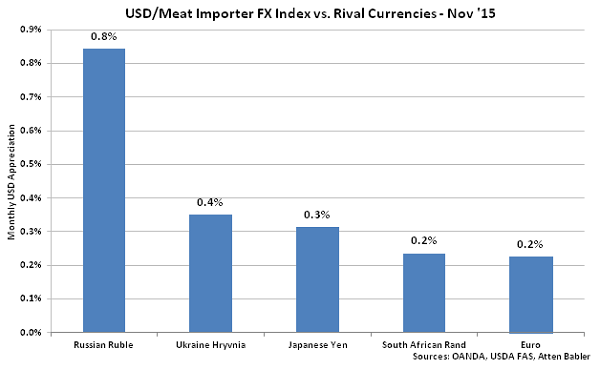 U.S. Meat Export Destinations:
Major destinations for U.S. meat exports are led by Mexico, followed by Japan, China, Canada, and Hong Kong.
U.S. Meat Export Destinations:
Major destinations for U.S. meat exports are led by Mexico, followed by Japan, China, Canada, and Hong Kong.
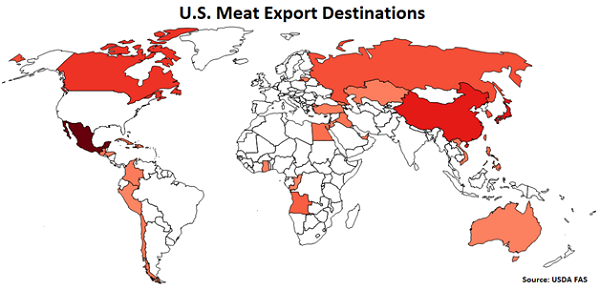 USD/Meat Domestic Importer FX Index:
The USD/Domestic Meat Importer FX Index increased 1.2 points in Nov ’15 to a new record high value of 224.6. The USD/Domestic Meat Importer FX Index has increased 51.2 points since the beginning of 2014 and 24.9 points throughout the past six months. A strengthening USD/Domestic Meat Importer FX Index results in less purchasing power for the traditional buyers of U.S. meat (represented in red in the U.S. Meat Export Destinations chart), ultimately resulting in less foreign demand, all other factors being equal. USD appreciation against the Angolan kwanza and Mexican peso has accounted for the majority of the gains since the beginning of 2014.
USD/Meat Domestic Importer FX Index:
The USD/Domestic Meat Importer FX Index increased 1.2 points in Nov ’15 to a new record high value of 224.6. The USD/Domestic Meat Importer FX Index has increased 51.2 points since the beginning of 2014 and 24.9 points throughout the past six months. A strengthening USD/Domestic Meat Importer FX Index results in less purchasing power for the traditional buyers of U.S. meat (represented in red in the U.S. Meat Export Destinations chart), ultimately resulting in less foreign demand, all other factors being equal. USD appreciation against the Angolan kwanza and Mexican peso has accounted for the majority of the gains since the beginning of 2014.
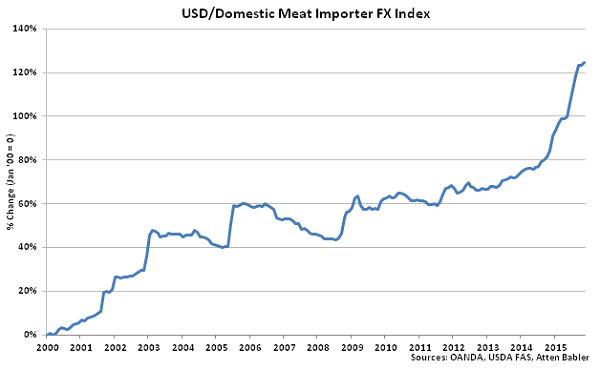 USD appreciation within the USD/Domestic Meat Importer FX Index during Nov ’15 was led by gains against the Russian ruble, followed by USD appreciated against the Japanese yen, Kazakhstani tenge, Mexican peso and Canadian dollar.
USD appreciation within the USD/Domestic Meat Importer FX Index during Nov ’15 was led by gains against the Russian ruble, followed by USD appreciated against the Japanese yen, Kazakhstani tenge, Mexican peso and Canadian dollar.
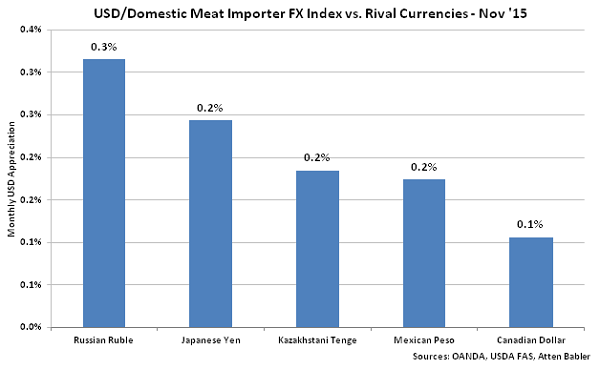
 USD/Meat Exporter FX Index:
The USD/Meat Exporter FX Index increased 0.2 points in Nov ’15 to a value of 163.2, which was the second highest figure on record. The USD/Meat Exporter FX Index has increased 41.3 points since the beginning of 2014 and 16.8 points throughout the past six months. A strengthening USD/Meat Exporter FX Index reduces the competitiveness of U.S. meat relative to other exporting regions (represented in green in the Global Meat Net Trade chart), ultimately resulting in less foreign demand, all other factors being equal. USD appreciation against the Brazilian real and Argentine peso has accounted for the majority of the gains since the beginning of 2014.
USD/Meat Exporter FX Index:
The USD/Meat Exporter FX Index increased 0.2 points in Nov ’15 to a value of 163.2, which was the second highest figure on record. The USD/Meat Exporter FX Index has increased 41.3 points since the beginning of 2014 and 16.8 points throughout the past six months. A strengthening USD/Meat Exporter FX Index reduces the competitiveness of U.S. meat relative to other exporting regions (represented in green in the Global Meat Net Trade chart), ultimately resulting in less foreign demand, all other factors being equal. USD appreciation against the Brazilian real and Argentine peso has accounted for the majority of the gains since the beginning of 2014.
 USD appreciation within the USD/Meat Exporter FX Index during Nov ’15 was led by gains against the euro, followed by USD appreciated against the Belarusian ruble, Argentine peso and Indian rupee. USD declines were exhibited against the Brazilian real.
USD appreciation within the USD/Meat Exporter FX Index during Nov ’15 was led by gains against the euro, followed by USD appreciated against the Belarusian ruble, Argentine peso and Indian rupee. USD declines were exhibited against the Brazilian real.
 USD/Meat Importer FX Index:
The USD/Meat Importer FX Index increased 2.4 points in Nov ’15 to a new record high value of 227.2. The USD/Meat Importer FX Index has increased 47.4 points since the beginning of 2014 and 23.0 points throughout the past six months. A strengthening USD/Meat Importer FX Index results in less purchasing power for major meat importing countries (represented in red in the Global Meat Net Trade chart), making U.S. meat more expensive to import. USD appreciation against the Angolan kwanza and the Russian ruble has accounted for the majority of the gains since the beginning of 2014.
USD/Meat Importer FX Index:
The USD/Meat Importer FX Index increased 2.4 points in Nov ’15 to a new record high value of 227.2. The USD/Meat Importer FX Index has increased 47.4 points since the beginning of 2014 and 23.0 points throughout the past six months. A strengthening USD/Meat Importer FX Index results in less purchasing power for major meat importing countries (represented in red in the Global Meat Net Trade chart), making U.S. meat more expensive to import. USD appreciation against the Angolan kwanza and the Russian ruble has accounted for the majority of the gains since the beginning of 2014.
 USD appreciation within the USD/Meat Importer FX Index during Nov ’15 was led by gains against the Russian ruble, followed by USD appreciated against the Ukraine hryvnia, Japanese yen, South African rand and euro.
USD appreciation within the USD/Meat Importer FX Index during Nov ’15 was led by gains against the Russian ruble, followed by USD appreciated against the Ukraine hryvnia, Japanese yen, South African rand and euro.
 U.S. Meat Export Destinations:
Major destinations for U.S. meat exports are led by Mexico, followed by Japan, China, Canada, and Hong Kong.
U.S. Meat Export Destinations:
Major destinations for U.S. meat exports are led by Mexico, followed by Japan, China, Canada, and Hong Kong.
 USD/Meat Domestic Importer FX Index:
The USD/Domestic Meat Importer FX Index increased 1.2 points in Nov ’15 to a new record high value of 224.6. The USD/Domestic Meat Importer FX Index has increased 51.2 points since the beginning of 2014 and 24.9 points throughout the past six months. A strengthening USD/Domestic Meat Importer FX Index results in less purchasing power for the traditional buyers of U.S. meat (represented in red in the U.S. Meat Export Destinations chart), ultimately resulting in less foreign demand, all other factors being equal. USD appreciation against the Angolan kwanza and Mexican peso has accounted for the majority of the gains since the beginning of 2014.
USD/Meat Domestic Importer FX Index:
The USD/Domestic Meat Importer FX Index increased 1.2 points in Nov ’15 to a new record high value of 224.6. The USD/Domestic Meat Importer FX Index has increased 51.2 points since the beginning of 2014 and 24.9 points throughout the past six months. A strengthening USD/Domestic Meat Importer FX Index results in less purchasing power for the traditional buyers of U.S. meat (represented in red in the U.S. Meat Export Destinations chart), ultimately resulting in less foreign demand, all other factors being equal. USD appreciation against the Angolan kwanza and Mexican peso has accounted for the majority of the gains since the beginning of 2014.
 USD appreciation within the USD/Domestic Meat Importer FX Index during Nov ’15 was led by gains against the Russian ruble, followed by USD appreciated against the Japanese yen, Kazakhstani tenge, Mexican peso and Canadian dollar.
USD appreciation within the USD/Domestic Meat Importer FX Index during Nov ’15 was led by gains against the Russian ruble, followed by USD appreciated against the Japanese yen, Kazakhstani tenge, Mexican peso and Canadian dollar.
